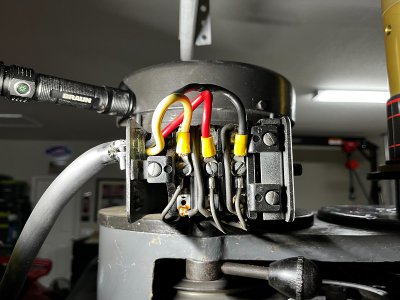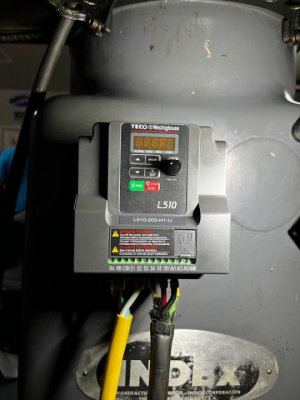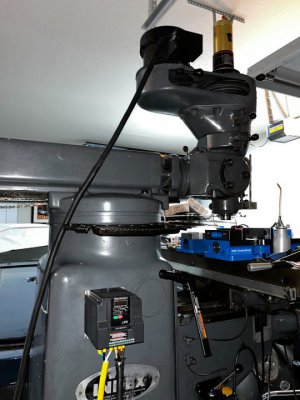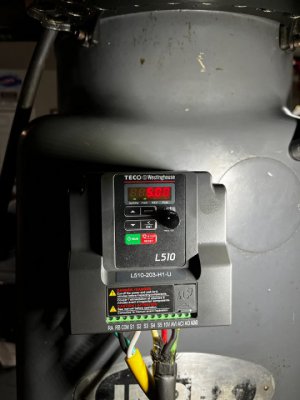Hi
@wachuko. So i'm new to this thread but spend 90 minutes reading the entire thing last night. I regret that I wasn't along for the ride from the beginning as I could've shared some of my experiences along the way because I also have a Wells-Index model 847 although mine is with the variable speed head. Purchased in March of 2020, days before the pandemic started (gave me something to do during all that)...
Like you, I had/have a lot of things I wanted to improve on it. First, a VFD to power it, then new scales and DRO. Powerfeed on the X only for me. Thought about the knee but I have a drill handy with an attachment I turned on my Grizzly G0752 lathe, and it raises/lowers super fast and I don't find it too distracting to do it that way for now at least. After powering it I turned my attention to building a power draw bar. I took inspiration from many different YT vids and ultimately fabricated my own. Ultimately it wasn't too difficult, I just put some thinking into the design over a couple of weeks. I modeled the design in Fusion 360 and then machined it to life. Here's an album with some pics/vids.
https://photos.app.goo.gl/FR1kjq9TH2HPJY3h9
As for the VFD, I chose this one from Factorymation.com.
https://www.factorymation.com/TD200-2002-1PH. I have the 2 HP Doerr motor and factorymation sales support confirmed it met all the specs for the motor. I has worked perfect for 2 years now and no complaints. I wired a 3 way switch to it to control fwd and reverse to compensate when I change from High to Low. Like you, I took off the on/off hanging bar but left the original power switch on the side of the head as I like the way it looks. But I wired through it to the VFD and control the power with the 3 way switch I mounted by the VFD on the right side of the machine on an extended arm/platform that my mill came with. I still plan on putting a more robust switch along with an E-Stop on but haven't gotten around to it yet. One item I debated with myself when purchasing the VFD was whether to buy one that had the ability to use an external braking resistor. At some level I wish that I had however I was able to program my VFD to ramp down the speed to off over a 2 second timespan when I turn the motor off. At almost any speed my VFD is able to complete the ramp down in that timeframe. When I tried any shorter time span it would work at slower RPMs but at higher speeds it would trip the overvoltage safety in the VFD. As far as I know this doesn't hurt the VFD and just required me to recycle the power each time that happened. So I settled on two seconds which is fine for me. You'll find such a feature on almost any VFD and the interesting thing is if you use it you really can't use your brake as the VFD is actually powering down the motor through that time period. If you apply the brake during the ramp down, you can actually cause an over voltage spike. I can also disable this feature altogether which simply allows the motor to coast to a stop. This is when I would use the brake but at the moment my brake pads are quite worn and would cost around $140 for a new set from Wells.
The most significant thing I had to do was to replace the spindle bearings. About a year after I had been using it and was starting to get more in tune with the tolerances of the machine I started taking measurements and unfortunately noticed that I had 2 1/2 thou (.0025) run out at the base of the spindle. I could actually move the spindle by hand with an endmill mounted (not powered of course). So I ultimately decided to have Wells replace the bearing and the reground the R8 inside taper as well. Got it back and the runout was at 2 tenths (.0002) which is right at or better than the spec so this was quite a relief. It cost ~$900 but shipping was $150 of that...
Lastly (for now), I have just completed removal of the head and pulled all of the auto-down feed gears and cleaned then reassembled. I recorded as much of the process as I could and am still in the process of editing the footage into something I could post as a reference to others down the road.
Here's another general album of pics of mine. Just a big dumping ground of photos/vids...
https://photos.app.goo.gl/2M6m6PnXpJrghHnw9






 Instructions said to just swap two wires... So I swapped T1 with T3 and voila! It is running in the correct direction. Having had such a success, decided to end the day on that high note...
Instructions said to just swap two wires... So I swapped T1 with T3 and voila! It is running in the correct direction. Having had such a success, decided to end the day on that high note... 
 I love those Braun flashlights too, they are awesome!
I love those Braun flashlights too, they are awesome!